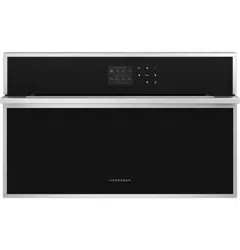Loading ...
Loading ...
Loading ...

49-2000696 Rev.2 11
USING THE OVEN
TRADITIONAL COOKING MODES
Your new oven has a variety of cooking modes to help you
get the best results. These modes are described below.
Remember, your new oven may perform differently than
the oven it is replacing.
Convection Bake
The Convection Bake mode is intended for single rack
cooking. This mode uses heat from the rear element,
along with air movement to enhance evenness. To use
this mode, select convection bake from the traditional
cooking menu, enter a temperature, and then press
SELECT. Temperatures for cooking foods in convection
bake are often set slightly lower than the same food
requires in a standard bake mode. Preheating is generally
recommended when using this mode.
Convection Roast
The Convection Roast mode is intended for roasting
foods on a single rack. This mode uses heat from the
lower, upper, and rear elements along with air movement
to improve browning. It is not necessary to convert
temperature. Check food earlier than the recipe suggested
time when using this mode, or use the probe. To use this
mode, select convection roast from the traditional cooking
menu and then press SELECT. It is not necessary to
preheat when using this mode.
Broiling Modes
Always broil with the door closed. Monitor food closely
while broiling. Use caution when broiling on upper rack
positions as placing food closer to the broil element
increases smoking, spattering, and the possibility of fats
igniting.
Try broiling foods that you would normally grill. Adjust rack
positions to adjust the intensity of the heat to the food.
Place foods closer to the broil element when a seared
surface and rare interior is desired. Thicker foods and
foods that need to be cooked through should be broiled on
a rack position farther from the broiler or by using lower
broiling temperatures. For best performance, center food
below the broil heating element.
The Broil Modes set to higher temperatures use intense
heat from the upper element to sear foods. Use higher
broil temperatures for thinner cuts of meat and/or foods
you prefer less done on the interior. The Broil modes set to
lower temperatures use less intense heat from the upper
element to cook food thoroughly while also producing
surface browning. Use lower broil temperatures for thicker
cuts of meat and/or foods that you would like cooked all
the way through.
Broil
The Broil mode uses heat from the upper element. To use
this mode, select broil from the traditional cooking menu
enter a temperature, and then press SELECT. It is not
necessary to preheat when using this mode.
Convection Broil
The Convection Broil mode uses the broil mode along with
air movement for improved searing and browning. To use
this mode, select convection broil from the traditional cooking
menu, enter a temperature, and then press SELECT.
COOKWARE GUIDELINES FOR
TRADITIONAL MODES
7KHPDWHULDOILQLVKDQGVL]HRIFRRNZDUHDIIHFWEDNLQJ
performance.
Dark, coated and dull pans absorb heat more readily than
light, shiny pans. Pans that absorb heat more readily can
result in a browner, crisper, and thicker crust. If using dark
and coated cookware check food earlier than minimum
cook time. If undesirable results are obtained with this type
of cookware consider reducing oven temperature by 25º F
next time.
Shiny pans can produce more evenly cooked baked goods
such as cakes and cookies.
Glass and ceramic pans heat slowly but retain heat well.
These types of pans work well for dishes such as pies and
custards.
Air insulated pans heat slowly and can reduce bottom
browning.
Keep cookware clean to promote even heating.
OVEN RACKS
Your oven has three rack positions. For baking and
roasting, position the rack so that food is approximately
centered in the oven. Adjusting rack position is one way to
impact cooking results.
When baking with multiple pans, ensure there is at least
1½" between pans to allow sufficient space for air to flow.
Oven Racks
Your oven has a traditional flat rack.
To avoid possible burns, place
the rack in the desired position
before you turn the oven on.
The oven rack has stops so that
when placed correctly on the supports it will stop before
coming completely out and will not tilt. When placing and
removing cookware, pull the rack out until it stops.
To Remove a Rack
Pull it toward you, tilt the front end up and pull it out.
To Replace a Rack
Tilt the front of the rack up, hook the rear locating posts
under the rack supports, push the rack back (past the
stoppers) and lower it into position. Push the rack all the
way in.
CAUTION
Use caution when removing a rack
from lowest position as door may be hot.
Loading ...
Loading ...
Loading ...
